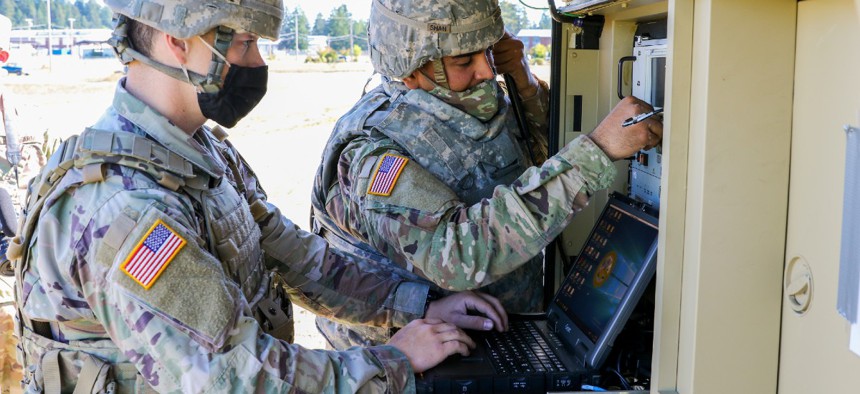Army G-6 Leader Outlines Priorities After Split from CIO

A U.S. Army signal specialist and an information technology Specialist prepare their equipment as part of the Spartan Week Convoy Operations on Sept. 29 at Joint Base Lewis-McChord, Wash. Devon Jones/U.S. Army
Deputy Chief of Staff Lt. Gen. John B. Morrison Jr. aims to use innovative hiring strategies to lure technical talent to his office.
The U.S. Army’s G-6 office, recently separated from the office of the chief information officer, has reached initial operating capability and will likely achieve full operational capability level some time later in 2021, according to the head of the G-6.
Newly appointed Deputy Chief of Staff of the G-6 Lt. Gen. John B. Morrison Jr. handles strategy, planning and implementation of the CIO’s policies while Greg Garcia, a civilian, serves as CIO. The Army announced it would split the CIO and the G-6 into two roles in June, and the separation officially took effect in August after former CIO/G-6 Lt. Gen. Bruce Crawford retired.
In a briefing with reporters Tuesday, Morrison outlined his priorities for the G-6 and discussed some of the top challenges he faces in turning his vision into reality. Getting the office loaded with appropriate talent is one of the immediate tasks needed to get the G-6 to full operational capability.
“I think the biggest challenge is hiring in the current operating environment, for lack of a better term,” Morrison said. “The skill sets that we are going to be wanting to go after are, as you know, in very high demand.”
Morrison said he has received approval to take a look at current vacancies and consider rewriting position descriptions to better tailor them for a split G-6 and CIO environment. Cloud, data, and cyber expertise are all needed, he added.
There’s steep competition for tech talent in both the private and public sectors, and the federal government is disadvantaged in this competition in a couple of ways. According to a recent report from the Partnership for Public Service, the length of time it takes to hire for a position in the federal government is 98 days, or more than twice the private sector average. High private-sector salary offerings also tend to give industry a hiring edge.
Morrison said he instructed his team to look into innovative hiring methods such as direct hire authorities to develop faster, more efficient hiring processes.
“I think this is one of those rare opportunities where you're able to set two organizations—and we've gotten great support from Army leadership—but support two organizations to really posture themselves and the Army for the future,” Morrison said.
Four pillars drive the G-6’s vision, according to Morrison. These pillars include creating a unified network rather than separate enterprise and tactical networks, orienting signal and cyber forces for multi-domain operations, reforming the risk management framework to ensure cybersecurity is baked into systems, and developing more efficient investment practices.
The G-6 will also be supporting the Army’s chief data officer, David Markowitz, another recent appointee, in implementing data standards for the Army. These data standards come both from the Army’s own policies as well as the Defense Department’s first enterprisewide data strategy, which was released earlier this month.
Morrison said the Army, like many organizations across the public and private sectors, needs to contend with massive amounts of data, some of which may be obsolete or redundant. One of the first challenges in implementing strong data standards is simply understanding what information the Army has on its hands.
Policies around data also need to be implemented in a coherent manner, taking into account the need for standardized, integrated and secure data as emerging technologies like artificial intelligence move to the fore, Morrison said. One opportunity Morrison sees for improving data practices in the Army is the idea of bringing in data engineers.
“It’s really not the folks who actually can do the hardcore analysis on data like data scientists, but how do you make data flow in that coherent way that is architected appropriately against how the network is architected,” Morrison said. “I think that's an opportunity and one that I look forward to working with the Cyber Center of Excellence on working through.”
NEXT STORY: State Dept. awards EIS data network contract



